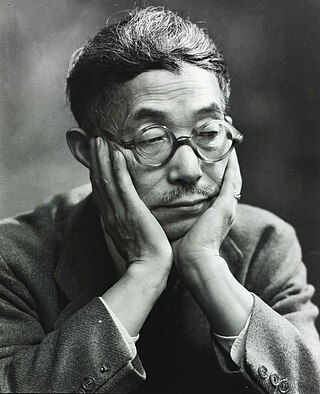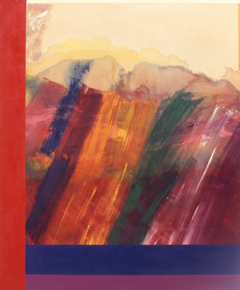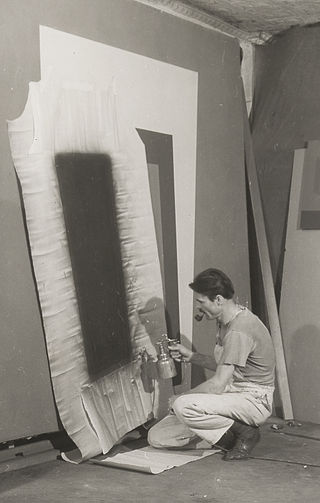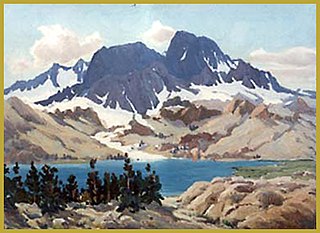
Yasuo Kuniyoshi was a Japanese-American painter, photographer and printmaker.

Joan Mitchell was an American artist who worked primarily in painting and printmaking, and also used pastel and made other works on paper. She was an active participant in the New York School of artists in the 1950s. A native of Chicago, she is associated with the American abstract expressionist movement, even though she lived in France for much of her career.

Ronnie Landfield is an American abstract painter. During his early career from the mid-1960s through the 1970s his paintings were associated with Lyrical Abstraction, and he was represented by the David Whitney Gallery and the André Emmerich Gallery.
Salomón Huerta is a painter based in Los Angeles, California. Huerta was born in Tijuana, Mexico, and grew up in the Boyle Heights neighborhood of Los Angeles. Huerta received a full scholarship to attend the Art Center College of Design in Pasadena and completed his MFA at UCLA in 1998.

June Claire Wayne was an American painter, printmaker, tapestry innovator, educator, and activist. She founded Tamarind Lithography Workshop (1960–1970), a then California-based nonprofit print shop dedicated to lithography.

Helen Lundeberg (1908–1999) was an American painter. Along with her husband Lorser Feitelson, she is credited with establishing the Post-Surrealist movement. Her artistic style changed over the course of her career, and has been described variously as Post-Surrealism, Hard-edge painting and Subjective Classicism.
The California Art Club (CAC) is one of the oldest and most active arts organizations in California. Founded in December 1909, it celebrated its centennial in 2009 and into the spring of 2010. The California Art Club originally evolved out of The Painters Club of Los Angeles, a short-lived group that lasted from 1906–09. The new organization was more inclusive, as it accepted women, sculptors and out-of-state artists.

Theodore Nikolai Lukits was a Romanian American portrait and landscape painter. His initial fame came from his portraits of glamorous actresses of the silent film era, but since his death, his Asian-inspired works, figures drawn from Hispanic California and pastel landscapes have received greater attention.
Hanson Duvall Puthuff was a landscape painter and muralist, born in Waverly, Missouri. Puthuff studied at the Art Institute of Chicago before moving to Colorado in 1889 to study at University of Denver Art School. He traveled to Los Angeles in 1903 and for 23 years worked as a commercial artist painting billboards while painting landscapes in his leisure. In 1926, he abandoned commercial art and devoted his full-time to fine art and exhibitions. He is nationally famous for his lyric interpretations of the Southern California deserts. Puthuff died in Corona del Mar on May 12, 1972.
Timothy J. Clark is an American artist best known for his large watercolor paintings of urban landscapes, still lifes, and interiors, and for his oil and watercolor portraits. His paintings and drawings are in the permanent collections of more than twenty art museums.

Balcomb Greene (1904–1990) was an American artist and teacher. He and his wife, artist Gertrude Glass Greene, were heavily involved in political activism to promote mainstream acceptance of abstract art and were founding members of the American Abstract Artists organization. His early style was completely non-objective. Juan Gris and Piet Mondrian as well as Pablo Picasso and Henri Matisse influenced his early style. From the 1940s his work "opened out to the light and space of natural form." He painted landscapes and figure. "He discerned the pain of a man, and hewed to it integrally from beginning to end…. In his study of the figure he did not stress anatomical shape but rather its intuitive, often conflicting spirit."

John Dwyer McLaughlin was an American abstract painter. Based primarily in California, he was a pioneer in minimalism and hard-edge painting. Considered one of the most significant Californian postwar artists, McLaughlin painted a focused body of geometric works that are completely devoid of any connection to everyday experience and objects, inspired by the Japanese notion of the void. He aimed to create paintings devoid of any object hood including but not limited to a gestures, representations and figuration. This led him to the rectangle. Leveraging a technique of layering rectangular bars on adjacent planes, McLaughlin creates works that provoke introspection and, consequently, a greater understanding of one's relationship to nature.
Peter Seitz Adams is an American artist. His body of work focuses on landscapes and seascapes created en plein air in oil or pastel as well as enigmatic figure and still-life paintings. He is noted for his colorful, high-key palette and broad brushwork. Adams has held numerous solo and group exhibitions in galleries and museums, including throughout California, the Western United States, and on the East Coast in Philadelphia, Vermont, and New York. Adams is the longest serving President of the California Art Club and has served on its board of directors in Pasadena, California from 1993 to 2018. He is also a writer on subjects relating to historic artists for the California Art Club Newsletter, as well as for a number of the organization's exhibition catalogs.

The terms California Impressionism and California Plein-Air Painting describe the large movement of 20th century artists who worked out of doors, directly from nature in California, United States. Their work became popular in the San Francisco Bay Area and Southern California in the first three decades after the turn of the 20th century. Considered to be a regional variation on American Impressionism, the California Impressionists are a subset of the California Plein-Air School.

Victor Stanley Matson (1895–1972) was an American artist representative of the California Plein-Air school of painting. He was active from the 1920s until his death. An active organizer for several Southern California arts organizations, he served as president of the historic California Art Club from 1961 to 1962. His work was widely exhibited with the Southland art clubs in an era when few galleries were interested in Plein-Air landscapes and he had a solo exhibition at Los Angeles City Hall in 1964.
Tonal Impressionism was an artistic style of "mood" paintings with simplified compositions, done in a limited range of colors, as with Tonalist works, but using the brighter, more chromatic palette of Impressionism. An exhibition titled "Tonal Impressionism" was curated by the art historian Harry Muir Kurtzworth for the Los Angeles Art Association Gallery at the Los Angeles Central Library in June 1937 with the works of a number of prominent California artists. In recent years, the term has also been used to describe a non-linear approach to painting where the subject is massed in with tonal values without the use of underdrawing.
California Tonalism was art movement that existed in California from circa 1890 to 1920. Tonalist are usually intimate works, painted with a limited palette. Tonalist paintings are softly expressive, suggestive rather than detailed, often depicting the landscape at twilight or evening, when there is an absence of contrast. Tonalist paintings could also be figurative, but in them, the figure was usually out of doors or in an interior in a low-key setting with little detail.
Agnes Tait was an American painter, pen-and-ink artist, lithographer, book illustrator, muralist and dancer.
Adelaide Deming was an American painter, associated for much of her life with Litchfield, Connecticut. She was the 1908 winner of the Beal Prize for her watercolor Moon Shadows.
Daisy Marguerite Hughes (1883–1968) was an American painter and lithographer.










